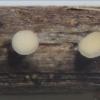
07-01-2026 10:24
 Danny Newman
Danny Newman
Pezicula sp. on indet. hardwood Appalachian Highl

07-01-2026 22:22
 Danny Newman
Danny Newman
Tatraea sp. on indet. hardwood The Swag, Great Sm

07-01-2026 17:29
 Marc Detollenaere
Marc Detollenaere
Dear Forum,On a barkless Populus I found some smal

10-11-2021 17:33
 Riet van Oosten
Riet van Oosten
Add-on topic http://www.ascofrance.com/forum/7059

07-01-2026 10:05
 Danny Newman
Danny Newman
cf. Chaetospermum on XylariaCosby Campground, Grea

02-01-2026 17:43
MARICEL PATINOHi there, although I couldn't see the fruitbody, I

04-01-2026 17:45
 Stephen Martin Mifsud
Stephen Martin Mifsud
I was happy to find these orange asmocyetes which
Hymenoscyphus s.s. on Juncus effusus
B Shelbourne,
06-11-2024 20:07
• The spores and excipulum suggest H. s.s.
• Seems to be H. caudatus.
Habitat: On dead stem of Juncus effusus, on the ground, damp when found, damp and muddy area, mixed deciduous woodland of mostly Castanea sativa, part of a large area of agricultural land being 'rewilded' (Knepp Estate), Low Weald, southern England, early November.
Apothecia: ~5 on a short piece of stem, < ~ 1 x 1 mm, whitish-yellowish, short stipitate.
Low magnification: Cupulate then more discoid, possibly growing from below the epidermis and associated with splits in the stem, pruinose appearance, receptacle and disc more cream to yellowish, receptacle internally whitish, disc opaquer, apparently remaining slightly concave, resp. margin remaining slightly raised, possibly eventually flattening, indistinct and uneven, stipe narrow cylindrical, more whitish or translucent.
Asci: Simple septa, rings bb, Hymenoscyphus-type, when immature (with fusion nucleus) and flaccid then elongated-lageniform with apex acute-rounded, with no thickening and could be mistaken for paraphyses but the apices and contents are clearly different, 8-spored but rarely only 4-spored with noticeably larger spores.
Spores: Ellipsoid to lacrymoid, shape quite variable, when heteropolar with the apex rounded to hemispherical and the base more acute, often asymmetric to +/- scutuloid in profile view, sometimes with a central restriction, OCI ~4, multi-guttulate in the asci, then often 1-3 large to medium and many small LBs towards each pole, apparently uninucleate but some free spores with a single? (transverse) septum, these spores slightly wider, some also with darker walls, large spores usually noticeable wider, more limoniform.
Free regular-size spores in water:
(15.9) 16.6-18.8 (20.1) × (4.3) 4.7-5.3 (5.5) µm, Q = (3.2) 3.23-4.0 (4.4), N = 27, mean = 17.8 × 5.0 µm, Q mean = 3.6.
Free large spores in water: 25.3 x 8.4 um, 20.8 x 6.3 um.
Paraphyses: Cylindrical, apex slightly to medium clavate-spatulate, with Hymenoscyphus type VBs at the apex, lowly-refractive, yellowish, some reddening with trauma, contents with moderate dextrinoid reaction.
Medullary: Text. porrecta-intricata.
Ectal: Text. prismatica.
Marginal cells: Starting at the upper flanks, broadly cylindrical or sometimes clavate, apex rounded to obtuse, occasionally more irregular, with yellowish contents at the apices, with strong dextrinoid reaction.
Hans-Otto Baral,
06-11-2024 22:13

Re : Hymenoscyphus caudatus on Juncus effusus
The idea of H. caudatus is not too bad, but I would be surprized if that would turn true.
H. suspectus I would expect, but I think the very low refractivity of the VBs in this collection forbid this. The VBs would point to what I think is typical H caudatus, but my collections have spores with much lower oil contents and often a median constriction.
Although probably of little value, I consider the size of the turgescent asci as more important than describing their shape. With such data one may sometimes have arguments e.g. for a key.
B Shelbourne,
06-11-2024 22:56
Re : Hymenoscyphus caudatus on Juncus effusus
Thank you. I appreciate the advice about measuring turgid asci, especially for species with similar spores.
I do think it is somehow different to the H. caudatus I found before on leaves of Salix, and I couldn't find any reports on this substrate. Although the spores are very similar and I couldn't find any closer species.
The apothecia do not redden with trauma in macro and do not have the highly refractive VBs. I thought this discounted many species in H. s.s, including H. suspectus. This species also seems to have some larger LBs in the fresh spores.
I do think it is somehow different to the H. caudatus I found before on leaves of Salix, and I couldn't find any reports on this substrate. Although the spores are very similar and I couldn't find any closer species.
The apothecia do not redden with trauma in macro and do not have the highly refractive VBs. I thought this discounted many species in H. s.s, including H. suspectus. This species also seems to have some larger LBs in the fresh spores.
Hans-Otto Baral,
07-11-2024 07:24

Re : Hymenoscyphus s.s. on Juncus effusus
Yes, the reddening is coupled with refractivity of VBs.
Let me please know the collectionn data so that I can label the files.
B Shelbourne,
07-11-2024 13:27
Re : Hymenoscyphus s.s. on Juncus effusus
Found by Max Mudie during a group foray.
BS 72:
01/11/24,
Knepp Estate (Wildland), West Grinstead, Horsham, West Sussex, England,
50.9731, -0.3480, alt. 9 m.
Would you call this H. aff. suspectus then?
Hans-Otto Baral,
07-11-2024 15:21

Re : Hymenoscyphus s.s. on Juncus effusus
No, that has spores over 20 µm long, I think 20-27.
B Shelbourne,
07-11-2024 18:09
Re : Hymenoscyphus s.s. on Juncus effusus
Ok, I will leave it as H. aff. caudatus for now, unless you have a better idea.





 Hymenium-0027.jpeg
Hymenium-0027.jpeg